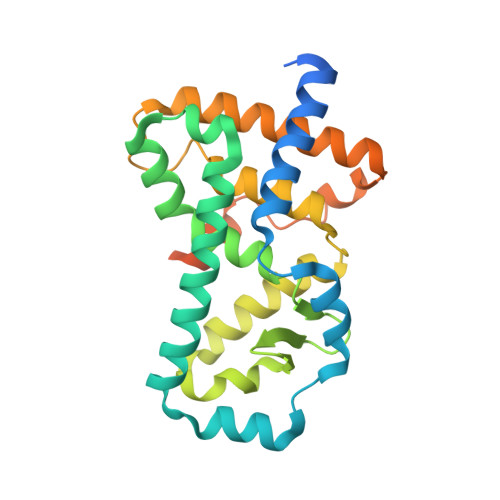Discovery of 2,6-difluorobenzyl ether series of phenyl ((R)-3-phenylpyrrolidin-3-yl)sulfones as surprisingly potent, selective and orally bioavailable ROR gamma t inverse agonists.
Duan, J.J., Jiang, B., Lu, Z., Stachura, S., Weigelt, C.A., Sack, J.S., Khan, J., Ruzanov, M., Wu, D.R., Yarde, M., Shen, D.R., Zhao, Q., Salter-Cid, L.M., Carter, P.H., Murali Dhar, T.G.(2020) Bioorg Med Chem Lett 30: 127441-127441
- PubMed: 32736080
- DOI: https://doi.org/10.1016/j.bmcl.2020.127441
- Primary Citation of Related Structures:
7JH2 - PubMed Abstract:
In an effort to discover oral inverse agonists of RORγt to treat inflammatory diseases, a new 2,6-difluorobenzyl ether series of cyclopentyl sulfones were found to be surprisingly more potent than the corresponding alcohol derivatives. When combined with a more optimized phenyl ((R)-3-phenylpyrrolidin-3-yl)sulfone template, the 2,6-difluorobenzyl ethers yielded a set of very potent RORγt inverse agonists (e.g., compound 26, RORγt Gal4 EC 50 11 nM) that are highly selective against PXR, LXRα and LXRβ. After optimizing for stability in human and mouse liver microsomes, compounds 29 and 38 were evaluated in vivo and found to have good oral bioavailability (56% and 101%, respectively) in mice. X-ray co-crystal structure of compound 27 in RORγt revealed that the bulky benzyl ether group causes helix 11 of the protein to partially uncoil to create a new, enlarged binding site, which nicely accommodates the benzyl ether moiety, leading to net potency gain.
Organizational Affiliation:
Research and Early Development, Bristol Myers Squibb Company, Princeton, NJ 08543-4000, United States. Electronic address: james.duan@bms.com.
















